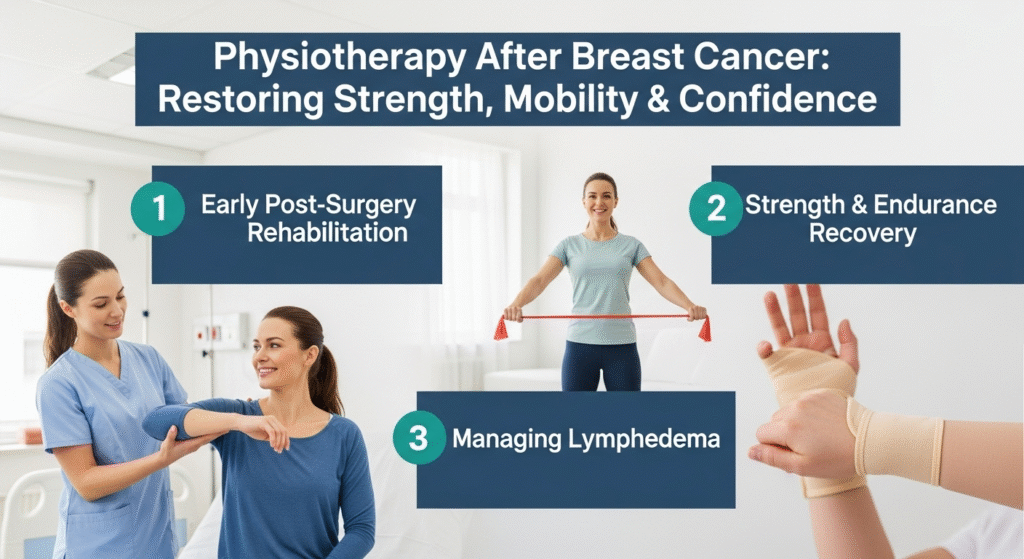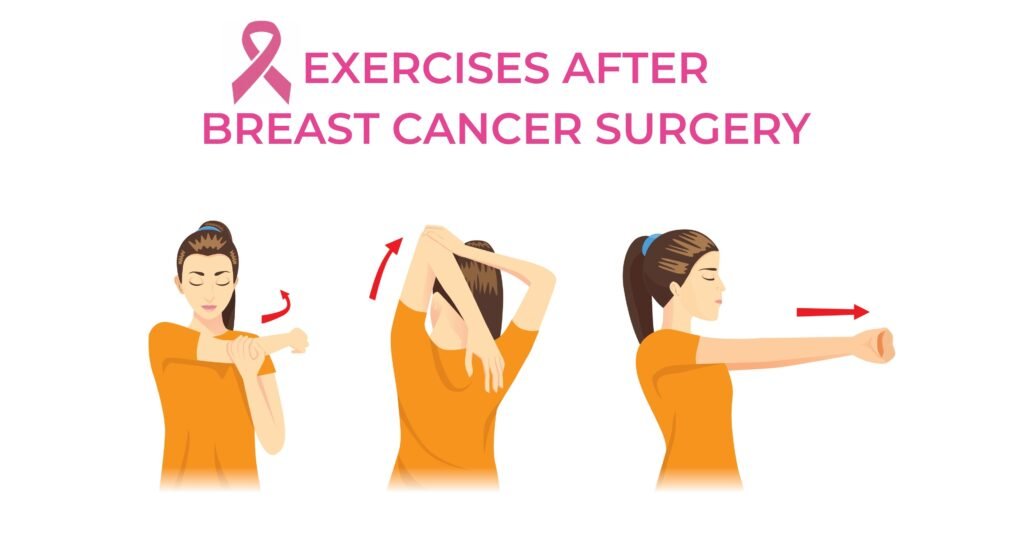Breast Cancer Physiotherapy: Recovery at AR Clinics

Understanding Breast Cancer & The Role of Physiotherapy in Recovery | AR Clinics Bahria Town Rawalpindi
Pinktober & The Power of Recovery:
Every October, the world turns pink to spread awareness about breast cancer, a disease that affects millions of women worldwide. Known as Pinktober, this month is dedicated to educating, empowering, and encouraging early detection and rehabilitation. At AR Clinics, a leading physiotherapy clinic in Bahria Town Rawalpindi, we stand with every fighter and survivor, focusing not only on healing but on helping them reclaim strength, mobility, and confidence through specialized physiotherapy after breast cancer.

Breast cancer is more than a medical condition; it’s an emotional and physical journey. The good news is that with advancements in physiotherapy management post breast cancer, survivors can regain control of their bodies and quality of life.
Understanding Breast Cancer: Causes, Risk Factors & Pathophysiology
1. What Is Breast Cancer?
Breast cancer occurs when abnormal cells in the breast begin to grow uncontrollably, forming a lump or tumor. Depending on its type and progression, it can invade nearby tissues or spread to other parts of the body.
2. Pathophysiology & Classification
The pathophysiology of breast cancer involves mutations in genes like BRCA1 and BRCA2 that regulate cell growth. Based on biological characteristics, breast cancer is classified as:
- Hormone receptor-positive (ER/PR positive)
- HER2-positive
- Triple-negative breast cancer (TNBC)
These categories influence the diagnosis of breast cancer and guide personalized treatment.
3. Risk Factors
Several factors increase the risk of developing breast cancer, including:
- Genetic predisposition (BRCA gene mutations)
- Prolonged estrogen exposure
- Family history of breast cancer
- Obesity and lack of physical activity
- Alcohol consumption and smoking
Maintaining a healthy lifestyle and regular screenings are key components of preventive physiotherapy for breast cancer.
Stages of Breast Cancer
Breast cancer is categorized into stages based on tumor size, lymph node involvement, and metastasis:
- Stage 0: Non-invasive (in situ), cancer cells remain confined.
- Stage I-II: Early stages, small tumor, may involve nearby lymph nodes.
- Stage III: Locally advanced, cancer has spread to multiple nodes or chest wall.
- Stage IV: Metastatic, cancer has spread to distant organs (lungs, bones, liver, brain).
Understanding these stages helps physiotherapists design appropriate postoperative breast cancer physiotherapy programs tailored to recovery goals.
Symptoms & Clinical Presentation:
Common signs and clinical presentations of breast cancer include:
- A lump or thickening in the breast or armpit
- Changes in breast shape or size
- Nipple inversion or discharge
- Skin dimpling or redness
- Persistent pain or swelling
Early diagnosis of breast cancer dramatically improves recovery outcomes, especially when combined with timely physical therapy management post-treatment.
Physiotherapy After Breast Cancer: Restoring Strength, Mobility & Confidence
After surgery, whether a mastectomy, lumpectomy, or breast-conserving surgery, patients often face stiffness, reduced shoulder mobility, pain, and swelling (lymphedema). Physiotherapy management post breast cancer is vital for reversing these effects and promoting faster healing.
1. Early Post-Surgery Rehabilitation
- Breathing Exercises: Maintain lung capacity and prevent postoperative complications.
- Gentle Shoulder Movements: Begin within a few days post-surgery to reduce stiffness.
- Scar Management: Once healed, scar massage helps improve circulation and prevent adhesion.
- Lymphedema Prevention: Gentle manual lymphatic drainage and Kinesio taping reduce swelling risks.
2. Strength & Endurance Recovery
As healing progresses, patients are guided through:
- Resistance training (bands or weights)
- Posture correction physiotherapy
- Myofascial release for scar tissue flexibility
- Aerobic activity following the FITT principle (Frequency, Intensity, Time, Type)
These enhance upper extremity strength, reduce fatigue, and restore function.

3. Managing Lymphedema
Lymphedema, swelling due to lymph node removal or radiation, can be lifelong. Physiotherapists at AR Clinics Rawalpindi provide:
- Manual lymphatic drainage therapy
- Compression garments and skin care
- Education on preventive measures like avoiding cuts, tight sleeves, or blood draws on the affected arm
Why Physiotherapy Is Essential in Breast Cancer Recovery
- Improves Range of Motion: Restores shoulder and arm mobility for daily tasks.
- Reduces Pain & Swelling: Addresses cording (axillary web syndrome) and scar tension.
- Prevents Postural Problems: Corrects muscle imbalances caused by surgery or radiotherapy.
- Boosts Quality of Life: Enhances both physical and emotional wellbeing, crucial for long-term survivorship.
- Promotes Independence: Enables patients to return to work, fitness, and normal routines confidently.
According to studies, early physiotherapist-led exercise intervention significantly improves arm and shoulder function, reduces pain, and minimizes upper limb dysfunction, ultimately restoring quality of life after breast cancer
Why Choose AR Clinics for Breast Cancer Rehabilitation:
At AR Clinics, we combine medical expertise, compassion, and innovation to help breast cancer survivors recover stronger. Located in Bahria Town Rawalpindi, our center is known for providing:
- Expert physiotherapists trained in oncology rehabilitation
- Female physiotherapists for comfort and privacy
- State-of-the-art rehabilitation center equipped for post-surgical physiotherapy
- Services including manual therapy, dry needling, cupping therapy (Hijama), and virtual physiotherapy sessions
- Holistic programs focusing on pain management, posture correction, and rehabilitation after breast cancer surgery
We focus on comprehensive physiotherapy management, from initial consultation to full recovery, ensuring that every patient regains not just mobility, but confidence.

FAQs About Physiotherapy After Breast Cancer:
Q1: When should physiotherapy start after breast cancer surgery?
Usually within the first few days post-surgery, depending on wound healing and medical clearance.
Q2: Can exercise cause harm after surgery?
No, when guided properly by a qualified physiotherapist. Exercises are gentle and progressively increased based on comfort.
Q3: What if swelling develops in the arm?
Contact your physiotherapist immediately. Early lymphedema therapy can prevent long-term complications.
Q4: How long does rehabilitation last?
Each patient’s recovery is unique, but most complete structured physiotherapy within 3–6 months with ongoing home exercises.
Q5: Is physiotherapy only for women?
While breast cancer predominantly affects women, men who undergo breast surgery also benefit from physiotherapy.

Book Your Session Now!
Recovery doesn’t end when treatment stops, it continues with strength, resilience, and care. Physiotherapy after breast cancer bridges the gap between survival and a full return to life. At AR Clinics, our specialists in physiotherapy in Bahria Town Rawalpindi are here to support you every step of the way, from pain management to rehabilitation after mastectomy or lumpectomy.
This Pinktober, take charge of your recovery. Book your physiotherapy consultation today with AR Clinics, because every survivor deserves to move freely, live confidently, and heal completely.
Visit: www.arclinics.net
Contact: +92 303 4280247
Location: AR Clinics, Bahria Town Phase 4, Rawalpindi




